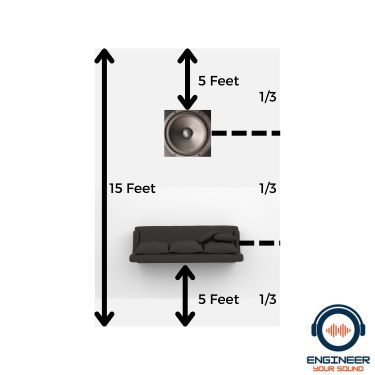Sound is a critical element of our experiences, whether binge-watching our favourite shows, immersing ourselves in a gripping video game, or simply unwinding to the soothing rhythm of our chosen tunes. Yet, the quality of these experiences is largely dependent on an often overlooked detail – speaker placement.
Positioning speakers correctly can markedly enhance sound delivery, creating a surround-sound environment that catapults your auditory experience to new heights.
The 1/3 rule for speaker placement suggests that speakers should be positioned about one-third into the room, measured from the front wall. This helps create a balanced soundstage and minimizes reflections.
In this article, I will explain the theory behind the 1/3 speaker placement rule, also known as the rule of thirds and offer practical tips to optimize your sound setup, drawing from my personal experiences with speaker placement.

What Is The 1/3 Rule For Speaker Placement?
The 1/3 rule for speaker placement, also known as the rule of thirds, is a guideline that audio enthusiasts and professionals often use to optimize the positioning of speakers within a room for the best sound quality.
This rule indicates that speakers should be placed approximately one-third the room’s length away from the front wall. This distance is calculated from the centre of the speaker driver to the wall behind it.
You then put the listening position (where you will be sitting) at the same distance from the back wall. This creates a balanced soundstage, with each speaker equidistant from the listener and avoids any reflections or echoes that can compromise audio quality.

Why Does Speaker Placement Matter?
Speaker placement is crucial because it affects how we perceive sound. The positioning of speakers in a room determines how sound waves travel and interact with obstacles.
The rule of thirds works in conjunction with understanding the room’s acoustics, such as reflections and standing waves, and aims to minimize these for a more defined and balanced soundstage.
By placing your speakers in this manner, you can achieve an optimal balance of direct and reflected sound, resulting in a more immersive audio experience.
7 Tips For Optimum Speaker Placement
- Identify the Sweet Spot: The sweet spot is the location in a room where the sound is at its best. Typically, this is in the central area of the room. Once identified, position your speakers so they face this spot.
- Apply the Rule of Thirds: Placing speakers one-third the room’s length away from the front wall can drastically enhance your listening experience. However, this is a starting point, and fine-tuning may be needed based on specific room acoustics.
- Avoid Corners and Walls: Speakers placed too close to corners or walls may produce booming or muffled sounds due to excessive bass buildup and sound reflection. Try to maintain some distance between the speakers and nearby walls.
- Symmetry is Key: Ensure your speakers are equidistant from each other and the listening position. This equidistant placement helps to create a balanced stereo image.
- Adjust Speaker Height: Ideally, the tweeters of your speakers should be at ear level when you’re seated. This may require purchasing speaker stands or risers to achieve the correct height.
- Experiment with Toe-In: ‘Toe-in’ refers to angling the speakers towards the listener. The degree of toe-in can significantly affect the sound stage width and imaging, so feel free to experiment and find the angle that sounds best to you.
- Consider Room Acoustics: The materials in your room (e.g., carpets, curtains, furniture) all affect how sound behaves. Pay attention to these elements when setting up your speakers — a room with lots of hard surfaces may benefit from some soft furnishings to help absorb excess sound.
Remember, these tips are just guidelines. The ultimate test for speaker placement is your ears. So, feel free to experiment and adjust as necessary to get the best sound quality.
Are There Set Rules For Speaker Placement?
While there are certain guidelines and principles many audio professionals abide by, such as the 1/3 rule, there is no one-size-fits-all rule for speaker placement. Each room is unique, possessing its own set of acoustic properties influenced by its shape, size, and the materials within it.
Thus, the placement of speakers often requires a degree of experimentation alongside the application of general rules. Sometimes, breaking these rules may even result in better sound quality.
I find that the rule of thirds is a great place to start; however, ultimately, trust your ears – they are the best judge of what sounds good.
Can Speakers Be Too Big For A Room?
Certainly, speakers can indeed be too big for a room. Large speakers in a small room can easily overpower the space, leading to sound distortions and an unbalanced audio output. The bass frequencies may become too overwhelming, while the higher frequencies can sound harsh or strained. This is because large speakers are designed to fill larger spaces and produce a greater volume of sound; in a confined space, the sound waves have less room to disperse and can cause acoustic issues.
Therefore, it’s important to consider the size of your room when choosing speakers and aim for a pair that matches the room’s dimensions and acoustics. This doesn’t mean small rooms can’t enjoy high-quality sound; it simply means you need to make smart choices in order to create a balanced, immersive soundstage.
Final Thoughts
In the journey of audio bliss, understanding speaker placement can make a significant impact on your listening experience.
While the 1/3 rule is a tried-and-tested guideline, remember that your room’s unique acoustics will also play a crucial role.
Experiment with different positions, take into account the size and materials of your room, and most importantly, trust your ears.
In the end, the best speaker placement is the one that delivers the most satisfying and immersive audio experience to you.
Happy listening!
